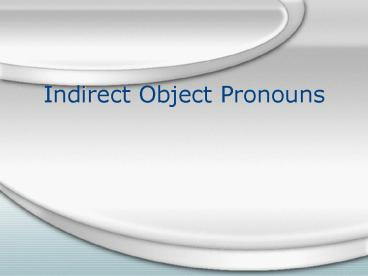Indirect Object Pronouns PowerPoint PPT Presentation
1 / 22
Title: Indirect Object Pronouns
1
Indirect Object Pronouns
2
The Indirect Object
- To identify the indirect object, you must answer
these questions - -To whom? or For whom? the action of the verb
is performed - The indirect object also tells us where the
direct object is going. - Indirect objects are the recipients of direct
objects
3
Practice
- 1) Robert bought me lunch.
- --The indirect object is me. For whom did
Robert buy lunch? For me. - 2) I gave the basketball to John.
- --The indirect object is John. The direct
object is going to John. - 3) John gave the book to Michael.
- --The indirect object is Michael. To whom is
the book going? To Michael.
4
Indirect objects in Spanish
- Like English, the Spanish indirect object is
identified the same way. - -Juan da el libro a Jorge.
- The indirect object for this is Jorge. The book
is going to Jorge. - -Julio compro un regalo para Marísol.
- The indirect object for this is Marísol. The book
is going to Marísol.
5
Indirect Objects and Their Pronouns
- In English we can use pronouns to take place of
the noun. The pronoun goes after the verb. - - Sarah gave the book to him.
- Him takes place of the person receiving
the book. - In Spanish we can use pronouns also to replace
the indirect object. The pronouns go before the
verb. - - Miguel te da el libro.
- Te takes place of you which is the person
receiving the book.
6
In this sentence, if you ask the question what,
you will find the Direct object, el pastel. If
you ask the question to whom, you will find the
Indirect object, a Jaime. You can also tell
what the IO is going to be because it will have
the word a/para in front of the noun.
7
LE AND LESThe IO pronouns le and les pr
esent a special problem because they are
ambiguous. That is, they can stand for different
things.leto (for) himto (for) herto (for)
you-formallesto (for) themto (for)
you-all-formal
8
Le and LesThe following sentences, while
grammatically correct, are ambiguousElla le
escribe una carta.Ella les escribe una
carta.Out of context, there is no way we can
know the meaning.Ella le escribe una carta.She
writes him a letter.She writes her a letter.She
writes you (formal) a letter.Ella les escribe
una carta.She writes them a letter.She writes
you-all (formal) a letter.
9
Le and LesSince le and les can mean more than
one thing, a prepositional phrase is often added
to remove the ambiguity.Ella le escribe a
Juan una carta.Ella le escribe a su hermana una
carta.Ella le escribe a usted una carta.Ella
les escribe a sus padres una carta.Ella les
escribe a ustedes una carta.
10
Sometimes a prepositional phrase is added not for
clarity, but rather for emphasis.Juan me da a mí
el dinero.John gives me the money.(emphasizing
that the money is given to me and not to someone
else)Juan te da a ti el dinero.John
gives you the money. (emphasis on you)There is
no ambiguity in the following sentence. It can
only mean one thing.Juan me da el dinero.John
gives me the money.The addition of a
prepositional phrase merely adds emphasis.Juan
me da a mí el dinero.John gives me the money.
11
Indirect object chart
12
Quiz
- 1. Mario saca el disquete para Luigi.
- - Change the sentence to fit the conjugated
verb with its pronoun. - -Replace Luigi with the indirect object _____.
- Nos
- Le
- Te
13
- The correct answer is B.
- The sentence should read
- Mario le saca el disquete.
14
- 2. Julio prende la máquina para Juan.
- - Change the sentence to fit the conjugated verb
with its pronoun. - -Replace Juan with the indirect object
pronoun____ - Les
- Te
- Le
15
- The correct answer is C.
- The sentence should read
- Julio le prende la máquina.
16
- 3. Alejandro compra chocolates para los
estudiantes. - -Change the sentence to fit the conjugated verb
with its pronoun. - -Replace los estudiantes with the indirect
object pronoun____ - Nos
- Les
- Leo
17
- The correct answer is B. Les
- The sentence should read
- Alejandro les compra chocolates.
18
- 4. Peter me da el ratón.
- What is the indirect object pronoun in this
sentence? Who is it replacing?
19
- The indirect object is me
- Me is replacing me.
20
- 5. Tú cantas para nosotros.
- -Change the sentence to fit the conjugated verb
with its pronoun. - -Replace nosotros with the correct indirect
object pronoun___ - Nos
- Yo
- Les
21
- The correct answer is A.
- The sentence should read
- Tú nos cantas.
22
Let's sum up the important points of this
lessonThe IO tells us where the DO is
going.The IO answers the question "to whom" or
"for whom."Sentences that have an IO usually
also have a DOSometimes the DO is not stated,
but rather is implied, or understood.The IO
pronouns are me, te, le, nos, os, les.Place the
pronoun before the conjugated verb.Think in
phrases, do not translate word-for-word.Le and
les are ambiguous.Prepositional phrases are
often used for clarity and for emphasis.

